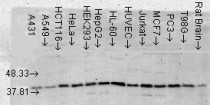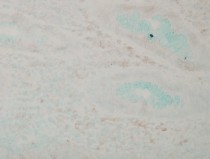ARG22268
anti-p38 MAPK antibody [9F12]
anti-p38 MAPK antibody [9F12] for ELISA,IHC-Formalin-fixed paraffin-embedded sections,Immunoprecipitation,Western blot and Human,Mouse,Rat
Cancer antibody; Immune System antibody; Signaling Transduction antibody; NF-kB Activation Study antibody
Overview
| Product Description | Mouse Monoclonal antibody [9F12] recognizes p38 MAPK |
|---|---|
| Tested Reactivity | Hu, Ms, Rat |
| Tested Application | ELISA, IHC-P, IP, WB |
| Specificity | Detects ~38kDa. |
| Host | Mouse |
| Clonality | Monoclonal |
| Clone | 9F12 |
| Isotype | IgG1 |
| Target Name | p38 MAPK |
| Antigen Species | Human |
| Immunogen | Full length Human p38 MAPK recombinant protein expressed in E.coli |
| Conjugation | Un-conjugated |
| Alternate Names | CSBP2; PRKM14; MAX-interacting protein 2; SAPK2A; Stress-activated protein kinase 2a; CSBP1; Mxi2; EC 2.7.11.24; CSBP; SAPK2a; RK; CSPB1; MAPK 14; p38; MAP kinase 14; MAP kinase MXI2; Cytokine suppressive anti-inflammatory drug-binding protein; MAP kinase p38 alpha; Mitogen-activated protein kinase p38 alpha; EXIP; CSAID-binding protein; p38ALPHA; PRKM15; Mitogen-activated protein kinase 14 |
Application Instructions
| Application Suggestion |
|
||||||||||
|---|---|---|---|---|---|---|---|---|---|---|---|
| Application Note | * The dilutions indicate recommended starting dilutions and the optimal dilutions or concentrations should be determined by the scientist. |
Properties
| Form | Liquid |
|---|---|
| Purification | Purification with Protein G. |
| Buffer | PBS, 0.09% Sodium azide and 50% Glycerol |
| Preservative | 0.09% Sodium azide |
| Stabilizer | 50% Glycerol |
| Concentration | 1 mg/ml |
| Storage Instruction | For continuous use, store undiluted antibody at 2-8°C for up to a week. For long-term storage, aliquot and store at -20°C. Storage in frost free freezers is not recommended. Avoid repeated freeze/thaw cycles. Suggest spin the vial prior to opening. The antibody solution should be gently mixed before use. |
| Note | For laboratory research only, not for drug, diagnostic or other use. |
Bioinformation
| Database Links | |
|---|---|
| Gene Symbol | MAPK14 |
| Gene Full Name | mitogen-activated protein kinase 14 |
| Background | The protein encoded by this gene is a member of the MAP kinase family. MAP kinases act as an integration point for multiple biochemical signals, and are involved in a wide variety of cellular processes such as proliferation, differentiation, transcription regulation and development. This kinase is activated by various environmental stresses and proinflammatory cytokines. The activation requires its phosphorylation by MAP kinase kinases (MKKs), or its autophosphorylation triggered by the interaction of MAP3K7IP1/TAB1 protein with this kinase. The substrates of this kinase include transcription regulator ATF2, MEF2C, and MAX, cell cycle regulator CDC25B, and tumor suppressor p53, which suggest the roles of this kinase in stress related transcription and cell cycle regulation, as well as in genotoxic stress response. Four alternatively spliced transcript variants of this gene encoding distinct isoforms have been reported. [provided by RefSeq, Jul 2008] |
| Function | Serine/threonine kinase which acts as an essential component of the MAP kinase signal transduction pathway. MAPK14 is one of the four p38 MAPKs which play an important role in the cascades of cellular responses evoked by extracellular stimuli such as proinflammatory cytokines or physical stress leading to direct activation of transcription factors. Accordingly, p38 MAPKs phosphorylate a broad range of proteins and it has been estimated that they may have approximately 200 to 300 substrates each. Some of the targets are downstream kinases which are activated through phosphorylation and further phosphorylate additional targets. RPS6KA5/MSK1 and RPS6KA4/MSK2 can directly phosphorylate and activate transcription factors such as CREB1, ATF1, the NF-kappa-B isoform RELA/NFKB3, STAT1 and STAT3, but can also phosphorylate histone H3 and the nucleosomal protein HMGN1. RPS6KA5/MSK1 and RPS6KA4/MSK2 play important roles in the rapid induction of immediate-early genes in response to stress or mitogenic stimuli, either by inducing chromatin remodeling or by recruiting the transcription machinery. On the other hand, two other kinase targets, MAPKAPK2/MK2 and MAPKAPK3/MK3, participate in the control of gene expression mostly at the post-transcriptional level, by phosphorylating ZFP36 (tristetraprolin) and ELAVL1, and by regulating EEF2K, which is important for the elongation of mRNA during translation. MKNK1/MNK1 and MKNK2/MNK2, two other kinases activated by p38 MAPKs, regulate protein synthesis by phosphorylating the initiation factor EIF4E2. MAPK14 interacts also with casein kinase II, leading to its activation through autophosphorylation and further phosphorylation of TP53/p53. In the cytoplasm, the p38 MAPK pathway is an important regulator of protein turnover. |
| Cellular Localization | Cytoplasm, Nucleus |
| Research Area | Cancer antibody; Immune System antibody; Signaling Transduction antibody; NF-kB Activation Study antibody |
| Calculated MW | 41 kDa |
| PTM | Dually phosphorylated on Thr-180 and Tyr-182 by the MAP2Ks MAP2K3/MKK3, MAP2K4/MKK4 and MAP2K6/MKK6 in response to inflammatory citokines, environmental stress or growth factors, which activates the enzyme. Dual phosphorylation can also be mediated by TAB1-mediated autophosphorylation. TCR engagement in T-cells also leads to Tyr-323 phosphorylation by ZAP70. Dephosphorylated and inactivated by DUPS1, DUSP10 and DUSP16. PPM1D also mediates dephosphorylation and inactivation of MAPK14 (PubMed:21283629). Acetylated at Lys-53 and Lys-152 by KAT2B and EP300. Acetylation at Lys-53 increases the affinity for ATP and enhances kinase activity. Lys-53 and Lys-152 are deacetylated by HDAC3. Ubiquitinated. Ubiquitination leads to degradation by the proteasome pathway. |
Images (2) Click the Picture to Zoom In
-
ARG22268 anti-p38 MAPK antibody [9F12] WB image
Western blot: Human cell lysates stained with ARG22268 anti-p38 MAPK antibody [9F12] at 1:1000 dilution.
-
ARG22268 anti-p38 MAPK antibody [9F12] IHC image
Immunohistochemistry: Formalin fixed colon carcinoma stained with ARG22268 anti-p38 MAPK antibody [9F12] at 1:10000 dilution (12 hours). Counterstain: Mayer Hematoxylin (purple/blue) nuclear stain at 200uL for 2 min at RT. Magnification: 40x.







